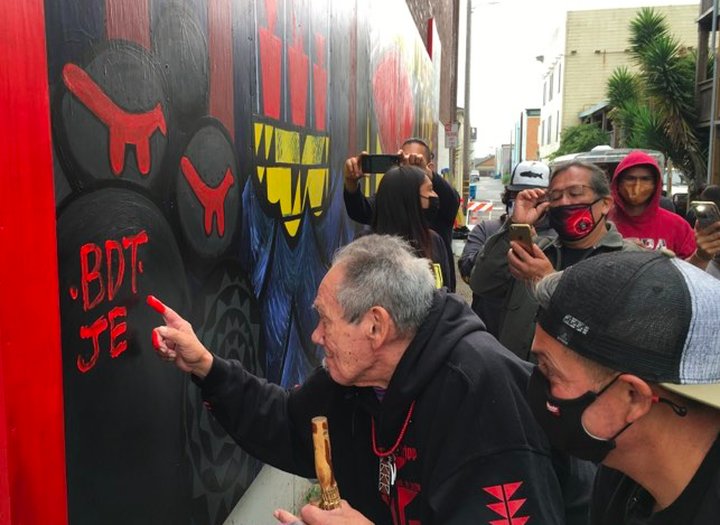
Karuk artist Brian Tripp signs his and his son’s initials on “The Sun Set Twice On the People That Day” mural on the Clarke Museum | Photo: Stephanie McGeary
###
Despite currently being in hospice care, 76-year-old Brian Tripp — a celebrated Karuk artist, poet and cultural leader — made his way to Opera Alley in Old Town Eureka on Thursday night to attend the dedication ceremony for a mural he helped design and paint more than 20 years ago.
“With what I’m going through now, I’m just so happy to be here today,” Tripp said to a group of at least 50 people — many who were Tripp’s friends and family members — masked and gathered in the alley next to the Clarke Museum. “I used to come to this museum when I was around and walk through it and see the baskets on the walls. I mean, this place has been an inspiration to me for I don’t know how long.”
The mural, entitled “The Sun Set Twice on the People That Day” — a line in a poem written by Tripp about the 1860 massacre of the Wiyot people on their sacred island, Tuluwat — was originally painted on wood panels by Tripp, his son Jasper Tripp, and several other Native artists and was installed on the side of the Eureka Theater in the year 2000. In 2019 the mural was removed for exterior maintenance to the theater and, after spending a couple of years in storage, is again up for display at its new home on the side of the Clarke Museum.
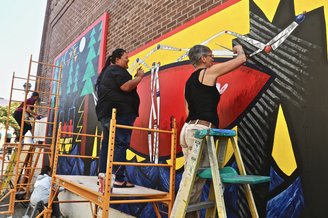
Alme Allen, Pimm Tripp-Allen and Danielle Brisco working during the festival | Photo: Andrew Goff
Inspired by Tripp’s poem, the mural uses bright colors and bold imagery to convey the story of the island and its significance to the Wiyot people, the relationship local tribes hold with the land and Humboldt Bay, and the struggles — both past and present — endured by Indigenous people.
“Out on an Island in the middle of the bay, the sun set twice on the people that day,” Tripp recited from his poem during the event. “The world they were making, someone else was taking, saying ‘Eureka, I found it,’ claiming it’s mine to own.”
Throughout last week a group of local artists, led by Alme Allen — who helped design and paint the mural in 2000 — were restoring the piece as a part of this year’s Eureka Street Art Festival. In his current condition, Tripp couldn’t help with the restoration, but he was able to sign his work on Thursday. Dipping his finger in red paint, Tripp used it to print his and his son’s initials on the piece.
Soon, a plaque displaying Tripp’s poem will be hung next to the mural, something that Allen explained the City did not wish to allow when the mural was first painted 21 years ago.
“This time that has not been a problem,” Allen said to the crowd during the ceremony. “So I credit the city for that — that there has been a change. There has been a change in the way that things are addressed. Real history is being acknowledged. This is one of the ways that art can heal.”
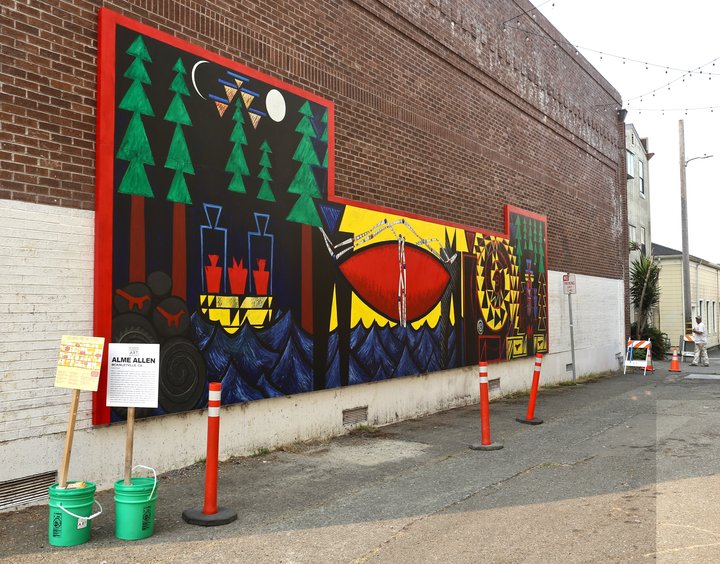
The completed mural | Photo: Andrew Goff
###
“The Sun Set Twice” is not the only mural worked on during this year’s festival that focuses on racist episodes of Humboldt’s past. Just a few blocks away from the Clarke Museum — in the alley between Fourth and Fifth Streets and E and F Streets — another piece of artwork shines a spotlight on Eureka’s all-but-forgotten historic Chinatown and the Chinese expulsion from Humboldt in 1885.
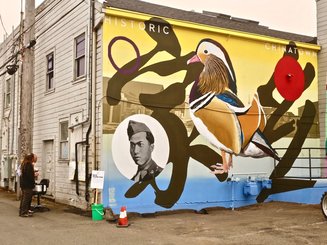
“Fowl” by David Kim in “Chinatown” Alley | Photo: Andrew Goff
The mural, entitled “Fowl”, was designed and painted by artist Dave Kim, with help from his apprentice Cate Be, as a part of the Eureka Chinatown Project — a project started by the Humboldt Asians and Pacific Islanders (HAPI) in an effort to raise awareness of the history of and discrimination toward Chinese people in Humboldt County.
During a press event at the mural on Thursday night — held just one hour before the dedication ceremony for Tripp’s mural — the artists, representatives from the City and from HAPI shared words on the mural’s significance and the origin of the Eureka Chinatown Project.
“Like many of you, I was surprised to learn that there was a Chinatown here in Eureka,” project coordinator Brieanne Mirjah said to the small gathering of people on Thursday evening. “I was even more shocked to not see any signs or recognition of it in our town. So for me, as a Chinese American and a brand new mother, I knew this was something our town direly needed.”
f
Prior to the Chinese Exclusion Act of 1882 — which prohibited the immigration of Chinese laborers — Eureka, like many cities, had a robust Chinese population and culture. After 1882, anti-Asian sentiment began to rise and in 1885, after living in the area for decades, Chinese families were forced to leave their Eureka homes. Chinese immigrants were not legally allowed back in Eureka until the 1950s in the U.S. for decades.
“Sadly the discrimination Chinese people experienced in the 1880s still continues today, as we are called disease-ridden and the cause of COVID-19, foul and culturally unfit for the country and blamed for stealing jobs,” Mirjah said.
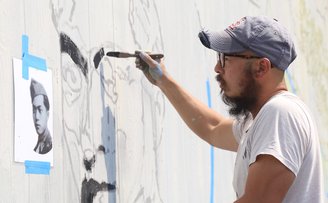
Kim working on the portrait of Ben Chin | Photo: Andrew Goff
With a backdrop of a picture of Eureka’s historical Chinatown, Kim’s mural centers around an image of a mandarin duck — which is native to China and represents young love and happiness, Kim explained to the crowd on Thursday. The title “Fowl” is a play on words, not only referring to the duck, but also to the fact that many people accused the Chinese of being foul. Due to poor city planning, sewage would pool in Eureka’s old Chinatown, creating unsanitary living conditions. Chinese people were often blamed for the stench and unsanitary environment.
The mural also includes an image of Ben Chin, who was the first Chinese immigrant to legally return to Eureka in 1955. Chin’s widow, Mary Chin; son, Don Chin; and niece, Jenny DePew, attended Thursday’s event to see the mural and pay respect to their relative.
The addition of the mural is only the first step in the Eureka Chinatown Project’s efforts to bring attention to the history of Chinese people in our area. Other projects include naming the alley to the Toisanese word for “Chinatown” to honor the Chinese people that had lived there, adding information about the area’s history to the city’s informational kiosks and wayfinding signs and the installation of a memorial statue monument near the alley.
“It’s been incredible to watch the projects come together and to watch the mural go up, but even more inspiring to witness the community come together for this cause, despite the challenges of the pandemic,” Mirjah said during Thursday’s event. “This project has bought together a diverse group of community members — we have Chinese and Asian Americans, allies, historians and educators — all who see the silences and gaps in our history and want to dig deeper. Everyone of us is here to create change that makes a long-lasting impact on our community.”
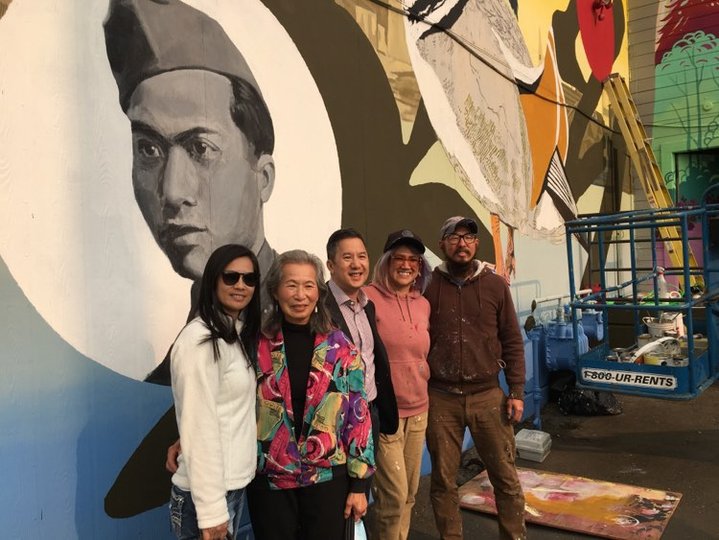
From left: Jenny DePew, Mary Chin, Don Chin, Cate Be and Dave Kim | Stephanie McGeary
CORRECTION: This article originally stated that Chinese immigrants were not legally allowed to return to Eureka until the 1950s. Although the Chinese who had already immigrated to the U.S. were legally allowed in Eureka following the expulsion, they did not return immediately due to the fear of hostility from the locals.
This article has also been changed to reflect that the alley name has not yet been decided and that the memorial will be a monument, not a statue.
The Outpost regrets the errors.
###
This year’s Eureka Street Art festival featured many unique works of art that have helped beautify the city’s downtown area, but these two pieces are especially significant, not only because they each bring attention to horrific events of our past, but also signify the progress that we have made as a city and a community.
In the two decades since “The Sun Set Twice” mural was first painted, the City of Eureka returned the land of Tuluwat to its rightful owners, the Wiyot people. Twenty years ago, the City did not want the message of Tripp’s poem to be included with the mural. Today, the City welcomes Tripp’s words. Until recently, the City contained no public acknowledgment of the Chinese community that was once here, or the fact that it was forced out.
Some of these may be small victories that certainly do not make up for the atrocities of the past, but they do show the shift in how we reckon the horrifying parts of history — rather than sweep them under the rug, we acknowledge them, so that we can move forward and try to heal.
Of course we still have so far to go, so much more work needs to be done to address the past, and to address the racism that persists today. The work may never be done. But, as Tripp wrote in his poem about Tuluwat, “we must give it our best.”
Although Tripp’s words were specific to the massacre at Tuluwat and the struggles of the Wiyot, the poem also conveys a message that can be appreciated by all — to not give up, to accept the past, take on the challenges of the present and maintain hope for the future.
We know it’s not over
We know it’s not done
For us, we know the fight has just begunMeanwhile we must take time to regroup
We must take time to rest
We know daylights coming
And we have to give it our best
###
PREVIOUSLY:
- ‘Eureka Chinatown Project’ Will Rename, Add Mural to Downtown Alley to Teach Community About the History of Chinese Americans in Humboldt
- ‘The Sun Set Twice on the People That Day’: Mural by Native Artists Brian Tripp and Alme Allen to Be Restored at Its New Home Outside the Clarke Museum
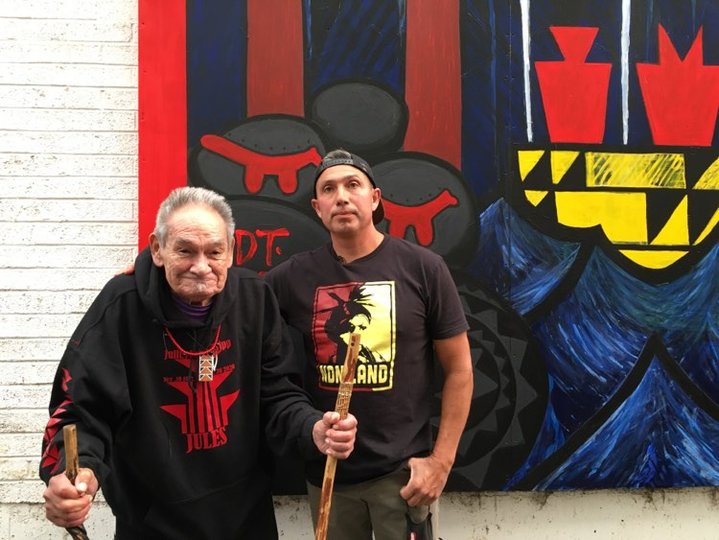
Tripp and Allen pose in front of the completed mural | Stephanie McGeary
CLICK TO MANAGE